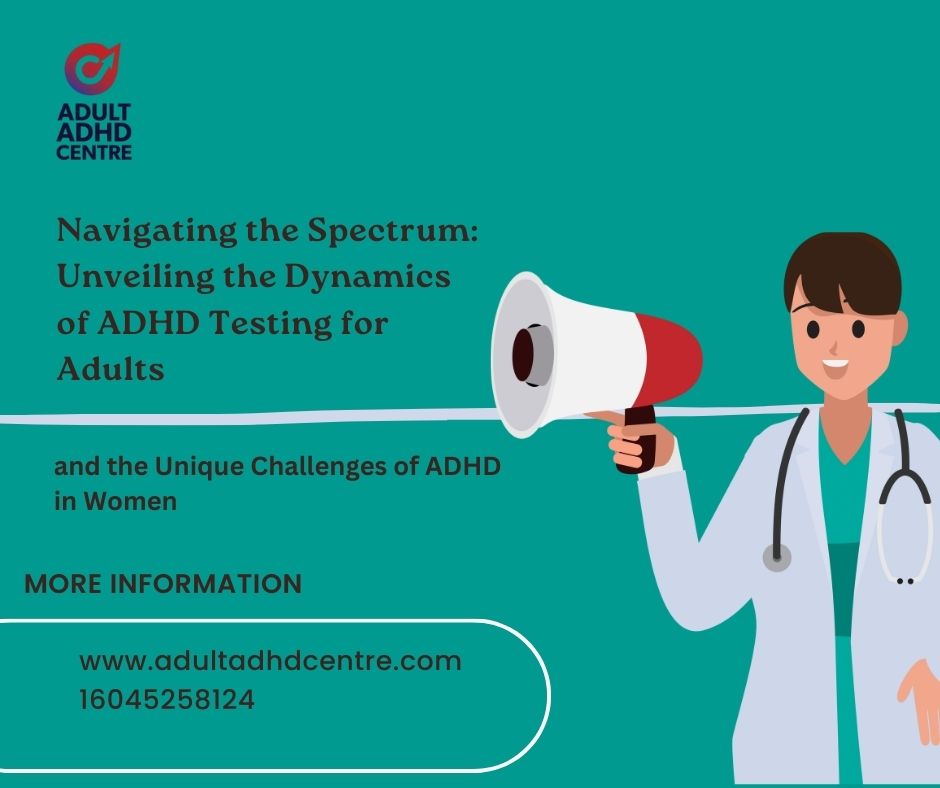ADHD, or Attention Deficit Hyperactivity Disorder, is often perceived as a childhood condition. However, its impact persists into adulthood, posing unique challenges that demand nuanced approaches. In this exploration, we delve into the intricacies of ADHD test for adults and shed light on the distinct aspects of ADHD in adult women.
ADHD Test for Adults: Unveiling the Diagnostic Process
- Recognizing Adult ADHD Symptoms:
The journey of diagnosing ADHD in adults commences with a careful examination of symptoms. While childhood symptoms often include hyperactivity and impulsivity, adult manifestations may lean more towards inattentiveness. Common signs include difficulty concentrating, forgetfulness, impulsivity, and struggles with time management.
- Comprehensive Clinical Assessment:
Diagnosing ADHD is not a one-size-fits-all process. Mental health professionals employ comprehensive clinical assessments, considering various aspects of an individual’s life. These assessments often involve interviews, behavioral observations, and the use of standardized rating scales.
- Utilizing ADHD Rating Scales:
ADHD rating scales serve as valuable tools in the diagnostic process. These self-report or observer-based assessments quantify and qualify ADHD-related behaviors. The scales consider various domains, such as attention span, organizational skills, and impulsivity, providing a structured framework for evaluation.
- Rule-Out Process:
Given the overlapping symptoms between ADHD and other mental health conditions, a rule-out process is essential. Professionals explore whether observed symptoms may be attributed to anxiety, depression, or other cognitive challenges before confirming an ADHD diagnosis.
- Consideration of Childhood History:
While ADHD is often perceived as a childhood condition, its roots are crucial in adult diagnosis. Professionals delve into childhood history, seeking evidence of symptoms that may have persisted into adulthood. This retrospective analysis provides a comprehensive understanding of an individual’s ADHD journey.
ADHD in Adult Women: Unmasking Gender-specific Challenges
- Manifestations beyond Hyperactivity:
ADHD in adult women often presents itself differently than in their male counterparts. While hyperactivity may still be present, women frequently exhibit internalized symptoms, such as excessive daydreaming, impulsivity in decision-making, and challenges with emotional regulation.
- Coping Mechanisms and Masking:
Women with ADHD may develop coping mechanisms that mask their symptoms, making the condition less apparent. This can lead to delayed diagnosis or misdiagnosis, as the external façade may not align with internal struggles.
- Impact on Relationships and Self-esteem:
The unique manifestations of ADHD in women can impact various aspects of their lives, including relationships and self-esteem. Difficulties in time management, forgetfulness, and impulsivity can strain personal and professional connections, contributing to feelings of inadequacy.
- Hormonal Influences:
Hormonal changes, particularly during menstruation, pregnancy, and menopause, can exacerbate ADHD symptoms in women. Understanding these influences is crucial for accurate diagnosis and tailored management strategies.
- Overlooked Co-occurring Conditions:
Women with ADHD may be more susceptible to co-occurring conditions, such as anxiety and depression. These conditions can intertwine with ADHD symptoms, necessitating a holistic approach to diagnosis and treatment.
Navigating the Intersection: ADHD Test for Adult Women
- Gender-sensitive Assessment Tools:
Recognizing the unique manifestations of ADHD in women, professionals utilize gender-sensitive assessment tools. These tools consider the diversity of symptoms and provide a more accurate representation of ADHD in adult women.
- In-depth Interviews:
In the diagnostic process for adult women, in-depth interviews play a crucial role. These conversations delve into various aspects of a woman’s life, exploring not only observable behaviors but also internal experiences that may not be readily apparent.
- Collaboration with Mental Health Experts:
Collaboration among professionals from different mental health disciplines is key. Specialists in ADHD, women’s health, and psychology work together to unravel the complexities of ADHD in adult women, ensuring a comprehensive and nuanced approach.
- Lifespan Perspective:
Understanding ADHD in women requires a lifespan perspective. The diagnostic journey considers not only current symptoms but also the trajectory of ADHD from childhood to adulthood. This temporal lens aids in recognizing evolving patterns and tailoring interventions accordingly.
- Culturally Competent Approach:
Cultural competence is integral in ADHD testing for adult women. Recognizing the impact of cultural and societal expectations on women’s roles and behaviors ensures that diagnoses and interventions are sensitive to individual experiences.
In Closing: A Tapestry of Understanding and Empathy
The landscape of Adhd test for adults, particularly women, is a multifaceted tapestry that demands careful navigation. Recognizing the unique manifestations and challenges associated with ADHD in adult women is a step towards fostering understanding, empathy, and tailored interventions.
As we unravel the dynamics of ADHD in adults and the intricate journey of women grappling with this condition, it becomes clear that a personalized, holistic, and gender-sensitive approach is paramount. In the intersection of clinical assessments, nuanced interviews, and collaborative efforts, we find the compass guiding us towards accurate diagnoses and effective support systems.

















